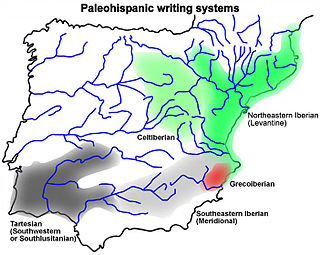The Iberian language was the language of an indigenous western European people identified by Greek and Roman sources who lived in the eastern and southeastern regions of the Iberian Peninsula in the pre-Migration Era. An ancient Iberian culture can be identified as existing between the 7th and 1st centuries BC, at least.

Celtiberian or Northeastern Hispano-Celtic is an extinct Indo-European language of the Celtic branch spoken by the Celtiberians in an area of the Iberian Peninsula between the headwaters of the Douro, Tagus, Júcar and Turia rivers and the Ebro river. This language is directly attested in nearly 200 inscriptions dated from the 2nd century BC to the 1st century AD, mainly in Celtiberian script, a direct adaptation of the northeastern Iberian script, but also in the Latin alphabet. The longest extant Celtiberian inscriptions are those on three Botorrita plaques, bronze plaques from Botorrita near Zaragoza, dating to the early 1st century BC, labeled Botorrita I, III and IV. Shorter and more fragmentary is the Novallas bronze tablet.

The Botorrita plaques are four bronze plaques discovered in Botorrita, near Zaragoza, Spain, dating to the late 2nd century BC, known as Botorrita I, II, III and IV.

The Celtiberian script is a Paleohispanic script that was the main writing system of the Celtiberian language, an extinct Continental Celtic language, which was also occasionally written using the Latin alphabet. This script is a direct adaptation of the northeastern Iberian script, the most frequently used of the Iberian scripts.

Lusitanian was an Indo-European Paleohispanic language. There has been support for either a connection with the ancient Italic languages or Celtic languages. It is known from only six sizeable inscriptions, dated from c. 1 CE, and numerous names of places (toponyms) and of gods (theonyms). The language was spoken in the territory inhabited by Lusitanian tribes, from the Douro to the Tagus rivers, territory that today falls in central Portugal and western Spain.

The Aquitanian language was the language of the ancient Aquitani, spoken on both sides of the western Pyrenees in ancient Aquitaine and in the areas south of the Pyrenees in the valleys of the Basque Country before the Roman conquest. It probably survived in Aquitania north of the Pyrenees until the Early Middle Ages.

Tartessian is an extinct Paleo-Hispanic language found in the Southwestern inscriptions of the Iberian Peninsula, mainly located in the south of Portugal, and the southwest of Spain. There are 95 such inscriptions; the longest has 82 readable signs. Around one third of them were found in Early Iron Age necropolises or other Iron Age burial sites associated with rich complex burials. It is usual to date them to the 7th century BC and to consider the southwestern script to be the most ancient Paleo-Hispanic script, with characters most closely resembling specific Phoenician letter forms found in inscriptions dated to c. 825 BC. Five of the inscriptions occur on stelae that have been interpreted as Late Bronze Age carved warrior gear from the Urnfield culture.

Old European is the term used by Hans Krahe (1964) for the language of the oldest reconstructed stratum of European hydronymy in Central and Western Europe.

The Espanca script is the first signary known of the Paleohispanic scripts. It is inscribed on a piece of slate, 48×28×2 cm. This alphabet consists of 27 letters written double. The 27 letters in the outer line are written in a better hand than those of the inner line, from which it has been inferred that the slate was a teaching exercise in which a master wrote the alphabet and a student copied it.

The Lacetani were an ancient Iberian (pre-Roman) people of the Iberian Peninsula.
Bandua was a theonym used to refer to a god or goddess worshipped in Iberia by Gallaeci and Lusitanians. Whether the name referred to a discrete deity or was an epithet applied to different deities is arguable.
Late Basquisation is a minority hypothesis that dates the arrival of the first speakers of the Basque language in northeastern Iberia from Aquitaine to the 5th or 6th century AD – as opposed to the mainstream view of it being the last remaining descendant of one of the pre-Indo-European languages of Prehistoric Europe.

The Pellendones, also designated Pelendones Celtiberorum and Cerindones, were an ancient pre-Roman Celtic people living on the Iberian Peninsula. From the early 4th century BC they inhabited the region near the source of the river Duero in what today is north-central Spain, an area comprising the north of Soria, the southeast of Burgos and the southwest of La Rioja provinces.

Cancho Roano is an archaeological site located in the municipality of Zalamea de la Serena, in the province of Badajoz, Spain. It is located three miles from Zalamea de la Serena in the direction of Quintana de la Serena Quintana, in a small valley along the stream Cagancha.

The Iacetani or Jacetani were a pre-Roman people who populated the area north of Aragon (Spain). They settled the Ebro valley, specifically in the area along the Pyrenees. Its capital was Iaca. According to Strabo, their land stretched from the Pyrenees to Lleida and Huesca. It is believed that they could be related to the Aquitanes. They were known to stamp coins. They also appear in the texts of Pliny the Elder and Ptolemy. However, it is likely that some of the ancient sources confuse them with the Lacetani.
Francisco Villar Liébana is a Spanish linguist, full professor of Indoeuropean linguistics at the University of Salamanca, beginning in 1979.
Peñalba de Villastar is a Celtiberian sanctuary in the municipality of Villastar, Aragon, Spain. About 10km south of Teruel, it is located at the eastern edge of Celtic Iberia. The sanctuary is along a cliff 1500m in length, where soft white limestone and marl rock bears hundreds of inscriptions and graffiti.










